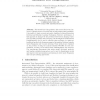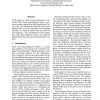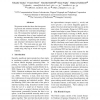215 search results - page 14 / 43 » Word Sense Disambiguation using Conceptual Density |
ACL
2003
13 years 8 months ago
2003
A central problem of word sense disambiguation (WSD) is the lack of manually sense-tagged data required for supervised learning. In this paper, we evaluate an approach to automati...
NLDB
2005
Springer
14 years 27 days ago
2005
Springer
Abstract. Automated Text Categorization has reached the levels of accuracy of human experts. Provided that enough training data is available, it is possible to learn accurate autom...
COLING
2002
13 years 7 months ago
2002
In this paper we report on our experiments on automatic Word Sense Disambiguation using a maximum entropy approach for both English and Chinese verbs. We compare the difficulty of...
LREC
2008
13 years 8 months ago
2008
Word Sense Disambiguation (WSD) is an intermediate task that serves as a means to an end defined by the application in which it is to be used. However, different applications have...
EMNLP
2007
13 years 8 months ago
2007
We present results that show that incorporating lexical and structural semantic information is effective for word sense disambiguation. We evaluated the method by using precise in...



